According to a recent survey, 86% of hiring managers said it's a challenge to find and hire technical talent. In such a competitive landscape, companies cannot afford to leave finding the best people up to chance.
Learn straight from a seasoned development company how to hire, keep and grow skilled developers like a pro.
Why it can be challenging to hire developers in today's work environment
The widening gap between supply and demand
The pandemic has brought about unprecedented change in how companies do business. More companies are embracing digital transformation as a way to stay relevant and competitive. This leads to soaring demand for experienced developers who can support businesses in implementing new technologies and navigating these changes.
As demand for skilled developers is increasing, so is the gap between need and available options. This is due to several reasons:
-
Keeping up with the latest technologies is a lot more difficult now than it was in the past. Developers need to continuously update their know-how to stay relevant in the market.
-
By focusing only on experienced professionals, companies often fail to invest in nurturing and growing the next generation of developers. In time, this can cause a shortage of talent.
-
Relying on freelance platforms to find and hire the cheapest developers encourages a race to the bottom in terms of compensation. Experienced professionals may feel discouraged due to a lack of competitive pay, leading to a skill shortage.
Changes in recruitment strategy to hire remote developers
Another change brought by the pandemic was the explosion of remote working. Despite significant advantages, like access to a global talent pool, hiring remotely also comes with challenges.
Most of these challenges have to do with hiring across cultures and the sheer amount of online interactions and job postings a recruiter has to handle on countless platforms.
To overcome the increasing complexity of communication and job posting management, companies face mounting pressure to put in place tools and a solid strategy for hiring remote developers.
Lengthy hiring process
The hiring process for developers is almost always longer compared to other roles, usually including one or more technical interviews and coding tasks.
This makes streamlining it all the more important. Failure to do so can make candidates lose interest and accept another offer.
According to CareerBuilder, 66% of candidates don’t wait two weeks for an answer before they move on to other opportunities.
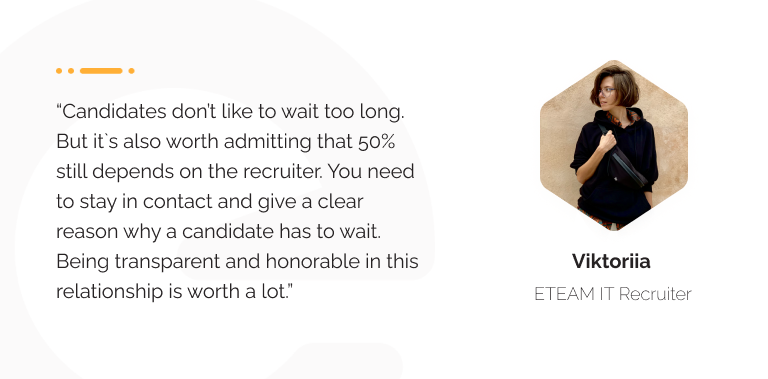
Job hopping and increased retention costs
Developers are known to switch jobs relatively frequently, seeking better opportunities or challenges. While job changes are normal and can lead to better career options, excessive and frequent turnover can impact team morale, productivity, and code quality.
Companies are faced with an increasing need to rethink their benefits, career growth opportunities, and work culture, so they can actually keep the software developers they hire.
Finding, hiring, and growing developers. Insights from a development company
While hiring developers can be especially challenging in today`s recruitment landscape, there are ways to overcome this. Finding skilled developers is only the first step in a much broader process that needs to take into account multiple aspects: from recruitment channels and tools to benefits, employer branding, and more.
Hiring the best programmers is a matter of thinking long-term and of having a broader view of talent acquisition. As Kateryna, ETEAM`s HR Manager and People Partner put it:
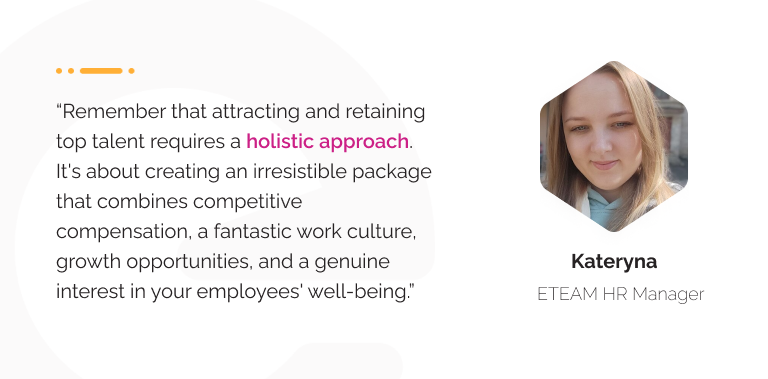
At ETEAM we follow a 4-step approach for building a strong dev team:
Step 1. Find
Step 2. Hire
Step 3. Keep
Step 4. Grow
Step 1. Find
Get clear on your requirements
Avoid generic job descriptions by using job-related keywords and target job posts toward the right fit for your project - consider the project`s duration, complexity, required skills, and tech stack.
Don`t forget to stay open-minded though. Good recruiters know how to find the right balance between ticking all the job description boxes and having realistic expectations.
Writing a good job description should be a joint effort between various roles. As a rule of thumb, at ETEAM we always draft and review developer job descriptions together with our technical team. This ensures there are no oversights. Imagine asking for 5 years of experience in a framework that was launched 3 years ago :)
Don't rely on only one channel
Gone are the days when all you had to do was post on a job board. Software developers have a more dynamic job search experience, with many companies competing for their attention. This requires catching their interest with targeted messages across multiple channels including social media, company website, LinkedIn ads, and employee referral programs.
Recruitment marketing is all about using every resource at your disposal, from employee stories to SEO, to make your company stand out.
Become part of the dev community
Programmers gravitate towards companies that speak the same language as them.
One of the best ways to attract them is through knowledge-sharing and becoming part of the dev community. Share your company`s tech knowledge at conferences, workshops, and hackathons. Engage open-source communities - active contributors to open-source projects have a passion for coding and can be excellent candidates.
At ETEAM we are invested in building a community of people who love coding. It's our best recruitment strategy!
Leverage the power of employer branding
Inbound recruitment is all about having talented software developers come to you, instead of seeking them yourself. Sounds good, right?
While inbound hiring is a valuable tool, it's also a lot of work. Part of this work is keeping your employer's brand fresh and appealing.
At ETEAM we recently underwent a brand revamp. This allowed us to manage our messaging and visual identity across all our channels in a more consistent manner, including on platforms like Glassdoor and Indeed.
Step 2. Hire
Create a smooth candidate journey
As our HR Manager likes to say “Creating a positive candidate experience is not just a checklist item.” You actually have to take the steps to create a smooth journey. This means answering candidate questions promptly and keeping them informed throughout the process, especially if it involves multiple steps.
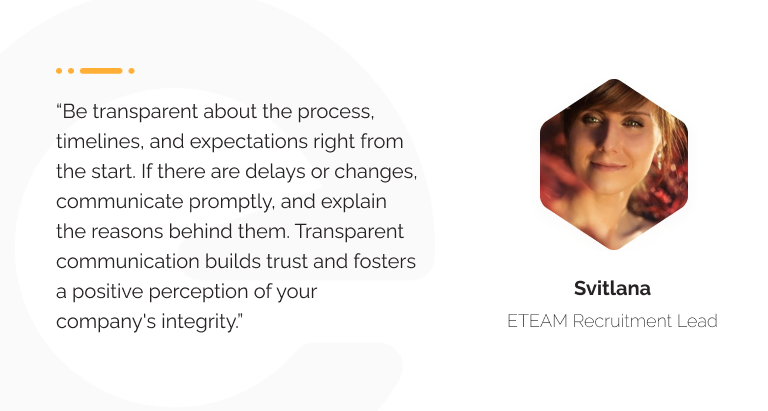
Last but not least, put some effort into rejection messages. Avoid the old “Thank you for your time” approach and give some actual feedback, especially if candidates already attended interviews or completed coding assignments.
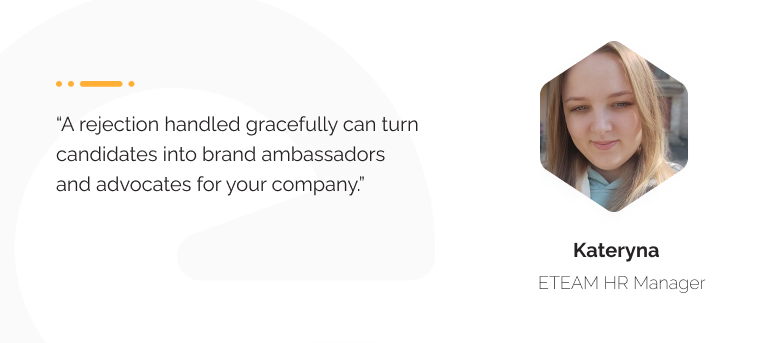
Invest in tools to streamline hiring
Hiring software developers takes time. Integrating tools like Applicant Tracking Systems (ATS) in your talent acquisition can simplify and speed up this process, lowering abandonment rates.
We use ATS to automate time-consuming administrative tasks and to streamline our remote hiring (don`t worry, important decisions are still made by us).
Remote hiring is tricky, so using proper tools can free up your time to keep candidates engaged and create a better experience.
Focus on real-life development tasks
Give developers a real problem to solve, or as close as possible to the actual challenges they will face on the job. Assessing how they approach such tasks is not only about code quality. It also shows how they handle problem-solving and how they apply their knowledge under time constraints.
A real-life development task can also expose candidates to new challenges and technologies, showing how willing they are to learn and adapt.
Balance soft and hard skills
At the end of the day, software development is a team effort. Programmers need good communication skills, whether it`s talking to a stakeholder or helping out a colleague. In fact, an Indeed survey placed soft skills above a Computer Science degree when evaluating tech talent.
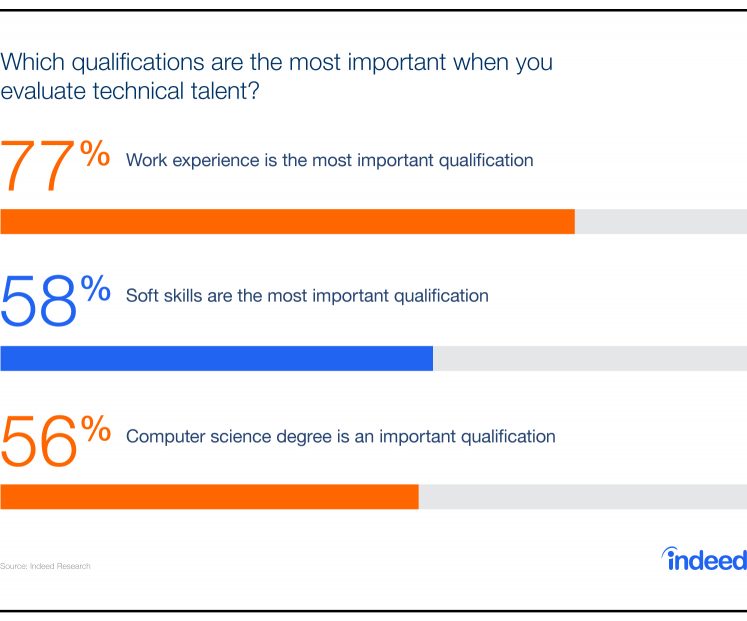
Source: Indeed Research
Technical interviews and coding tests only address one side of the spectrum. Here are some of the ways we assess developer soft skills and keep a fair balance:
-
We pay close attention to how candidates express their ideas and thoughts during video interviews, including body language and eye contact
-
We ask them about previous experiences working in a team setting, including how they handle disagreements
-
We use role-playing scenarios to simulate real-life interaction
Don't underestimate cultural fit
Even the most skilled developers won't be able to shine if they don`t fit in. Behavioral questions are a great way to assess if candidates resonate with your company's values and work style.
“Tell me about a time when you…” and “Describe a situation where you…” are some common examples. By seeing how candidates behaved in the past, you can understand how they will likely respond in the future. You can use this to inquire about their preferred work environment and assess their answers against your values and how you do things.
Step 3. Keep
Create a positive onboarding experience
Onboarding sets the expectations regarding how things will be from now on. By making programmers feel supported in their new job, you build trust and loyalty.
We use onboarding as an opportunity to provide new developers with an overview of our company and workflows, including our technical playbook and procedures. During the first weeks, we like to schedule regular check-ins to address concerns, give and receive feedback and provide additional resources, if needed.
Provide and ask for regular feedback
Getting feedback early and often is important not just in development, but also in work relationships. It gives programmers purpose and meaning by allowing them to understand the direct impact they have within the team and on the project outcome.
To make sure feedback stays constructive, put in place guidelines. One of our rules is “feedback should be given to actions and deeds, not personality”.
Feedback is a two-way street. Encourage programmers to also give you feedback through employer surveys and eNPS scoring.
Don`t assume money is the only factor
Competitive pay is an important factor in attracting tech talent but it's not the only one. As the tech industry is maturing, the focus is shifting from just maximizing income to seeking a healthier work-life balance.
This makes non-compensation benefits more important than ever, with developers increasingly prioritizing wellness, health, social responsibility, and purpose-driven organizations.
Create a developer-friendly work environment
Creating a dev-friendly environment is the best way to secure talent and to make sure your hiring efforts are not wasted. Here are a few ways to make this happen:
-
Make it easy for developers to collaborate by putting in place internal tools and coding standards (beware though, too many tools can harm productivity)
-
Invest in infrastructure, including hardware and software
-
Prioritize work autonomy and flexibility
-
Involve developers in projects in a meaningful way
-
Minimize unnecessary meetings, let developers focus on coding
-
Leverage AI to automate processes (developers don't like boring tasks)
Step 4. Grow
Encourage knowledge sharing & continuous learning
According to Hired`s 2022 State of Software Engineers report, 72.2% of respondents mentioned new challenges and continuous learning as their biggest career motivators. More than half also said they are worried their skills are becoming less relevant.
Making knowledge sharing and professional development a priority can be a great asset in your hiring efforts, attracting developers who want to stay competitive.
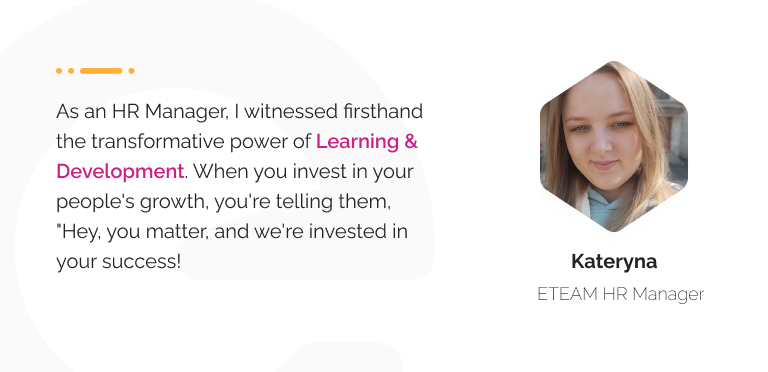
Developer meetups are a good way for team members to share their experiences on a given topic or technology. We use them both as an opportunity to socialize and exchange best practices and the latest industry news. We also hold internal project demos, where developers can learn from other teams even if they are not working on that specific project.
Consider combining internal knowledge sharing and external training, like certifications and conferences, when building your continuous learning strategy.
Measure developer success and celebrate wins
You can't grow if you don't set goals and measure your progress. To attract top software talent you need to build an environment where meaningful work is rewarded.
Don`t count lines of code, measure outcomes instead, like following through with delivery dates or delivering more features more often. Celebrate wins as a team, but also reward individual performance by implementing effective employee recognition and rewards programs.
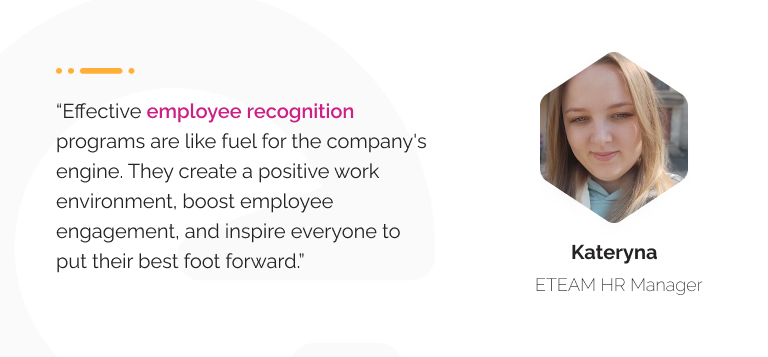
To sum it up
Hiring skilled software developers is no longer a matter of just writing a catchy job description or asking the right interview questions. In an increasingly competitive landscape, where developers stay at a job for an average of only 16 months, keeping and nurturing the talent you find is also important.
This makes attracting and hiring top talent an end-to-end effort, from sourcing and screening to investing in employer branding, learning and development, and employee recognition.
Creating a meaningful work environment is the best way to ensure your recruitment efforts don't go to waste and you don't constantly find yourself back to square one.








